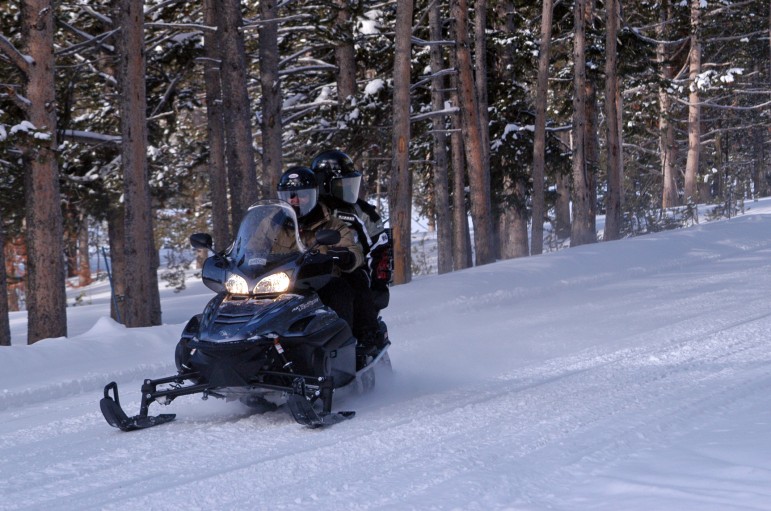
CODY, WYO. — After more than 15 years of contentious debate over snowmobile travel in Yellowstone National Park, the National Park Service on Tuesday released a final winter-use plan that appears to have a solid chance of avoiding legal challenges.
The latest plan follows six previous failed attempts and a total of more than 1.1 million public comments. Environmental groups have said snowmobiles are loud, dirty and stressful for animals. Tour operators have said increasing travel restrictions have made it difficult to stay in business.
But those objections appear largely addressed in the new plan, which could govern over-snow travel in Yellowstone for the next 15-20 years.
Winter use for 2013-14 will follow the same rules as the past four years, with up to 318 snowmobiles and 78 snow coaches allowed in the park each day.
The 2014-15 winter season will see traffic managed under a new process that governs so-called “transportation events.” The system encourages what park managers say will be a “market-based approach” in determining the mix of snowmobiles and snow coaches in the park each day.
“It shouldn’t matter whether it’s a snowmobile or a snow coach,” Yellowstone Superintendent Dan Wenk said in a Tuesday morning phone interview with Yellowstone Gate. “What should matter is how we provide access with the least amount of impact to the resources.”
That approach seems to be resonating well with winter tour operators, environmental groups, elected officials and the public. While earlier plans have drawn lawsuits and bitter public debate, no past litigants appear poised to challenge the current plan, Wenk said.
The final plan closely mirrors a draft version released last year. It will manage snowmobile and snow coach traffic by allowing up to 110 so-called “transportation events” each day. A transportation event is defined as one snow coach or a group of up to 10 snowmobiles, averaging seven seasonally.
On average, over the course of an entire season, the plan allows for average daily limits of approximately 50 groups of around seven snowmobiles each and a total of 60 snow coaches entering one-at-a-time.
Commercial tour operators will be able to use their allocated transportation events for snowmobiles, snow coaches or a mix of both.
New program
A new pilot program will let one non-commercial guide take up to four guests daily through each gate. Details of that program will be worked out later, but guides must pass an online course, and will use a government web site to reserve entry dates based on a lottery system.
New best-available-technology standards will be required for snowmobiles by the 2015-16 season, and for snow coaches by the winter of 2016-17.
Travel over Sylvan Pass between the East Gate and Fishing Bridge will continue under existing guidelines.
Compared to the existing plan, Wenk said the new scheme will allow for winter operations that are cleaner, quieter and less stressful for wildlife while increasing the overall potential limits for visitors in the park.
Tim Stevens, Northern Rockies regional director for the National Parks Conservation Association, said the park service “has hit the sweet spot” in crafting a plan that is acceptable across a wide range of diverse interests.
Stevens praised Wenk for “resolving this very thorny issue by bringing a completely different perspective with a unique, problem-solving approach” that involved “genuine engagement” with all parties.
While the Association disagrees with elements of the plan that maintain access over Sylvan Pass and allow for non-commercial guides, Stevens said those were “relatively minor issues compared to the big picture.”
The Bozeman, Mont.-based Greater Yellowstone Coalition, which has sued over objections to prior winter-use plans, appears unlikely to challenge this one.
Executive Director Caroline Byrd said the plan is “a significant step in the right direction” in efforts to protect the park’s wildlife, air quality and visitor experiences.
Wenk said the plan has met with approval thus far because managers sought additional scientific data on key issues, and worked to meet early and often with anyone who expressed an interest.
Financial hurdles
Gary Fales, the lone snowmobile guide serving the Cody, Wyo. area at Yellowstone’s East Gate, said that Wenk “came in with an open mind and figured out a solution that’s probably the best plan there can be considering the circumstances.”
But complying with the park’s best-available-technology requirements means upgrading to new snowmobiles in two years, Fales said—a high financial hurdle for small operators.
Another issue that concerns some operators is how the Park Service will award new concessions contracts for winter travel.
All permits and contracts for winter travel expire in March 2014, and operators must make new applications for contracts that will start in December 2014. Unlike in past years, each applicant will be expected to provide both snow coach and snowmobile services as part of the market-based approach encouraged under the new plan.
Because many current providers operate either snowmobiles or snow coaches, but not both, “that is going to greatly complicate a lot of people’s lives,” said Clyde Seely, owner of See Yellowstone in West Yellowstone, Mont.
Seely and other tour operators heard details of the new plan Tuesday during a conference call with Wenk.
With a push to have new contracts approved by the spring, that doesn’t leave much time for small operators to budget for new machines or consider partnering with others, he said.
But the concessions process is separate from the winter-use rule, Seely said, and the Park Service has some flexibility in requesting proposals from operators.
Seely said he expected operators to voice their concerns about being required to offer both snowmobiles and snow coaches at meetings with the Park Service scheduled later this month in West Yellowstone and Jackson, Wyo.
“But aside from that, I believe the implementation of this new rule will be advantageous to both the public and the operators,” he said. “I don’t want to see that held up one more year.”
Contact Yellowstone Gate at 307-213-9818 or [email protected].
